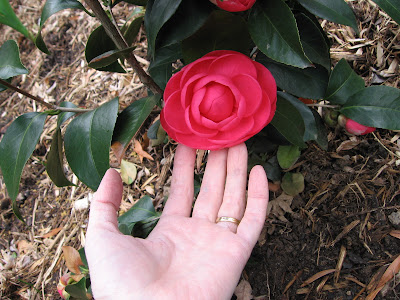Having lived in Washington, DC for over 20 years, I've seen people come and go. Given the ever-changing nature of government both here and abroad, I know a lot of well-traveled people who have lived across the globe. With our ever-shrinking electronic world,
I can see a secret garden in Charleston, a rosaria on the Italian coast, or even a friend's creeper-covered wall back in Minnesota. Of course, these experiences are not the same thing as being
there. But what if travel is not in
cards? I, for one, tour my garden. Even a suburban yard has roots all over
earth.
We begin with my earliest bloomer, the lovely, delicate
winter hazel (in this case, Corylopsis
paucifloris). Like Emily's bewitching witch hazel, it comes from Asia, in this case probably Japan
(though plants, like people, are happy to cross political boundaries!) The blooms are followed by pleated
leaves. After the fall, the twisted
branches add a striking and amusing quality to the winter landscape. I envision it around the boundaries of a
Japanese tea garden. I will watch the
beauty of the tea service, and swear to myself that I will start living
mindfully…
Another plant from Asia offers less drama in its flowers,
but has the most amazing fragrance. Daphne odora earns its name,
transporting me to another place far outside of Washington DC’s infamous
beltway.
The Purple Plum tree first grew in East Asia and South East
Europe. It has rich purple foliage that
contrasts wonderfully with all the green of summertime; I assumed that it was
planted by a previous owner solely for that purpose. Imagine my surprise when I saw this during springtime in a Washington suburb.
Few plants evoke Asia quite like the camellia. It was originally cultivated in China and
Japan. Camellias are often seen in art
from these countries: paintings, screens, and porcelain objects, and de Gournay appropriated
it for my dream wallpaper.
While I’d prefer to see them in their native land, to hold one in your
hand is a tangible connection to an elegant world.
I have a beautiful fall bloomer, which I had referred to generically as an aster. A friend (a horticulture professor, no less!) informed me that it was, in fact, a Chrysanthemum zawadskii, also known as a Korean Chrysanthemum. It begins with small flowers and, in time, becomes a huge, pale peach-colored puff.
But I am not picky. I happily take my mind to the Mediterranean, where I will see the blazing colors of snapdragons. I will gaze upon the sea, hopefully clad in Givenchy from the trip to Paris. (The cat came, originally, from Africa.)

Climbing hydrangeas likely
orginated in the Himalayan region, and are native to China, Japan, Korea and,
most surprisingly, Siberia. My climbing
hydrangea is, year by year, conquering the back of my house. I am a little concerned about its weed-like
exuberance and will happily pass on the trip to Siberia.
My favorite world traveler is the azalea, which is found in
Asia, Europe and North America. The
diversity of its flowers, the shading of colors from pale pastels to
fluorescent pinks, purples and oranges make it welcome everyplace. According to Wikipedia, the Chinese refer to
azaleas as siangish shu or the "thinking of home bush.”





.jpg)





No comments:
Post a Comment
Thank you for your comment!